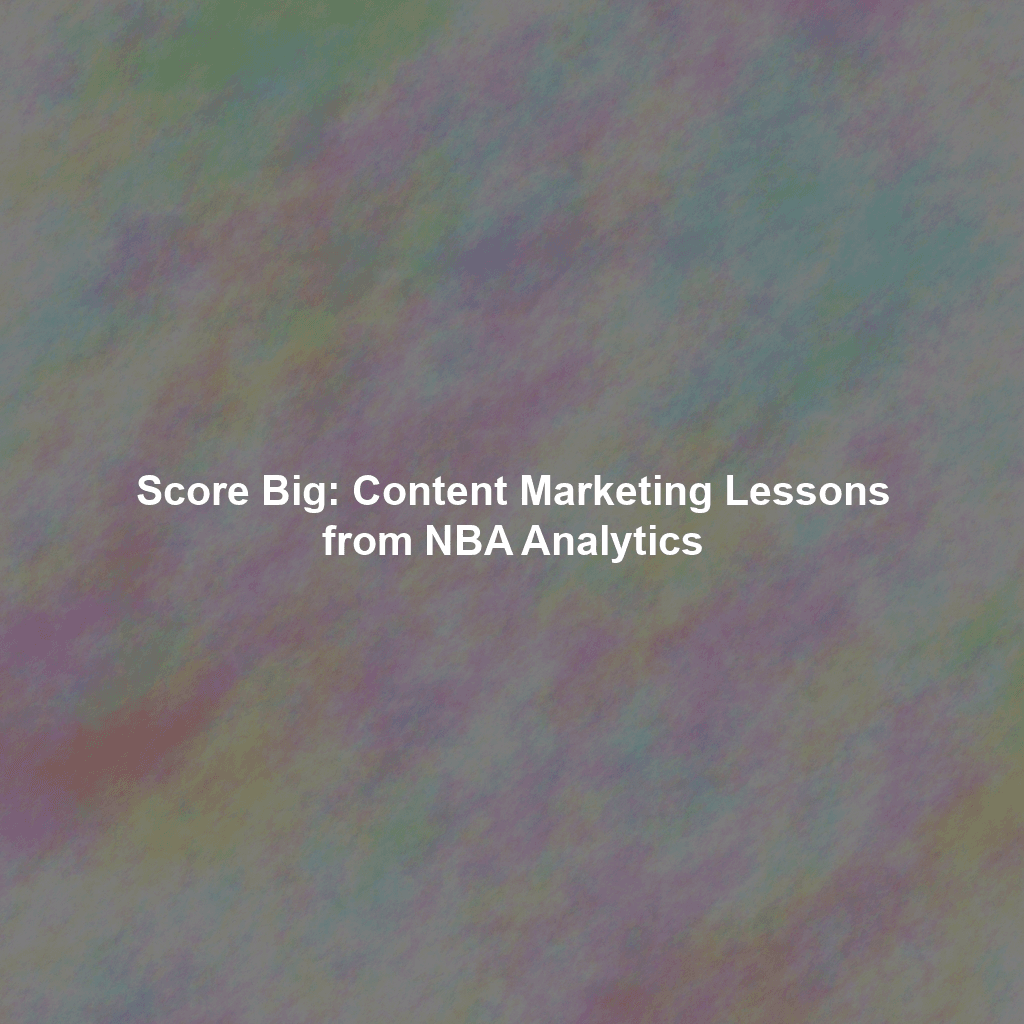Introduction: Beyond the Box Score – The NBA’s Data Revolution
The NBA’s Data Playbook: Key Strategies and Applications
Let’s dive into specific examples of how NBA teams are utilizing data analytics to dominate the competition and engage with fans:
Player Performance Analytics: Content Optimization’s MVP
NBA teams track a vast array of player stats, going far beyond traditional metrics like points, rebounds, and assists. They analyze shot charts (showing where players score most effectively), usage rates (how often a player is involved in the offense), and plus/minus ratings (measuring a player’s impact on the team’s score while they’re on the court). This data helps coaches make informed decisions about player rotations, game plans, and individual training programs.
Your Content Marketing Takeaway: Just like NBA teams analyze player performance, you need to analyze your content performance. Use tools like Google Analytics, SEMrush, and Ahrefs to track metrics like:
- Page views: Which content pieces are attracting the most attention?
- Bounce rate: Are visitors immediately leaving certain pages? This could indicate poor content quality or mismatched expectations.
- Time on page: How long are visitors engaging with your content? Longer time on page suggests higher engagement.
- Conversion rates: Are your blog posts leading to sign-ups, downloads, or purchases?
- Social shares: Is your content being shared on social media platforms?
- Search engine rankings: Where does your content rank for relevant keywords?
By analyzing these metrics, you can identify your “star players” (high-performing content) and your “benchwarmers” (underperforming content). Then, optimize your strategy accordingly. For example, if a particular blog post has a high bounce rate, you might need to improve its introduction, readability, or call to action.
Example: Imagine you’re running a blog about personal finance. You notice that your article on “Investing for Beginners” has a much higher bounce rate than your article on “Advanced Portfolio Diversification.” This suggests that the “Investing for Beginners” article isn’t meeting the needs of its intended audience. You could revise the introduction to be more engaging, simplify the language, or add more visuals to improve its readability.
Resource: Google Analytics is a free and powerful tool for tracking website traffic and user behavior.
Audience Segmentation: Finding Your Ideal Fan Base
NBA teams don’t treat all fans the same. They segment their audience based on demographics (age, location, income), interests (e.g., specific players, team history), and purchase behavior (ticket purchases, merchandise sales). This allows them to tailor their marketing messages and offers to specific groups of fans.
Your Content Marketing Takeaway: Don’t create generic content that appeals to everyone. Segment your audience based on factors like:
- Demographics: Age, gender, location, income, job title.
- Interests: Topics they’re interested in, problems they’re trying to solve.
- Behavior: Past purchases, website activity, email engagement.
- Pain points: What challenges are they facing?
Then, create content that speaks directly to each segment’s needs and interests. For example, you could create a beginner’s guide for new customers and an advanced tutorial for experienced users. You can segment your email list and send targeted emails based on subscriber behavior.
Example: A software company could segment its audience into small business owners and enterprise clients. They could then create content that addresses the specific challenges faced by each group. For example, content for small business owners might focus on affordability and ease of use, while content for enterprise clients might focus on scalability and security.
Resource: Many email marketing platforms like Mailchimp and Klaviyo offer robust segmentation features.
Predictive Analytics: Forecasting Content Trends and Opportunities
NBA teams use predictive analytics to forecast player performance, identify potential injuries, and even predict ticket sales. By analyzing historical data and identifying patterns, they can make informed decisions about the future.
Your Content Marketing Takeaway: While you can’t predict the future with certainty, you can use data to anticipate trends and identify opportunities in your industry. Use tools like Google Trends to see what topics are trending and analyze competitor content to identify gaps in the market. You can also use social listening tools to monitor conversations about your brand and industry.
Example: If you’re a marketing agency specializing in social media, you could use Google Trends to track the popularity of different social media platforms. If you see a surge in interest in a new platform, you could create content about that platform and position yourself as an expert. You can also monitor social media conversations to identify emerging trends and topics that your audience is interested in.
Resource: Google Trends is a free tool for exploring search trends and identifying popular topics.
Real-Time Data Analysis: Adjusting Your Content Strategy on the Fly
NBA teams use real-time data to adjust their game plans during games. Coaches analyze player performance, opponent strategies, and crowd sentiment to make quick decisions that can impact the outcome of the game. For instance, a coach might notice that a particular player is struggling against a specific defender and adjust the offensive strategy accordingly.
Your Content Marketing Takeaway: Don’t set your content strategy in stone and forget about it. Monitor your content performance in real-time and make adjustments as needed. If you notice that a particular piece of content is not performing well, don’t be afraid to tweak it or even scrap it altogether. Track social media engagement and respond to comments and questions promptly. Use A/B testing to experiment with different headlines, images, and calls to action.
Example: If you’re running a social media campaign and you notice that a particular ad is not getting any clicks, you can pause the ad and try a different creative. If you’re live-streaming an event and you notice that the audience is losing interest, you can change the topic or introduce a new guest.
Resource: Many social media platforms offer built-in analytics dashboards that provide real-time data on engagement and reach.
Practical Steps: Implementing NBA-Inspired Data Strategies in Your Content Marketing
Now that you understand the principles behind NBA data analytics, let’s translate those concepts into actionable steps you can take to improve your content marketing strategy:
1. Define Your Key Performance Indicators (KPIs): What Does Success Look Like?
Just like NBA teams define their goals (winning games, making the playoffs), you need to define your content marketing KPIs. What are you trying to achieve with your content? Do you want to increase website traffic, generate leads, or improve brand awareness? Once you know your goals, you can identify the metrics that will help you track your progress. Examples of common content marketing KPIs include website traffic, bounce rate, time on page, conversion rates, social shares, and search engine rankings.
2. Invest in the Right Tools: Building Your Analytics Toolkit
You don’t need expensive software to get started with data-driven content marketing. Many free or low-cost tools can provide valuable insights. Here are a few essential tools:
- Google Analytics: Track website traffic, user behavior, and conversion rates.
- Google Search Console: Monitor your website’s performance in Google Search.
- SEMrush or Ahrefs: Analyze your competitors’ content and identify keyword opportunities.
- Social media analytics dashboards: Track engagement and reach on social media platforms.
- Email marketing platform analytics: Track open rates, click-through rates, and conversion rates for your email campaigns.
3. Collect and Analyze Data: Uncovering Hidden Insights
Once you have the right tools in place, start collecting data. Monitor your website traffic, social media engagement, and email campaign performance. Look for patterns and trends that can help you understand what’s working and what’s not. Don’t just collect data for the sake of it; analyze it and use it to inform your decisions. Ask yourself questions like:
- Which content pieces are generating the most leads?
- Which keywords are driving the most traffic to your website?
- Which social media platforms are generating the most engagement?
- Are there any pages with high bounce rates that need to be improved?
4. A/B Test Everything: Experiment and Optimize
A/B testing involves testing two different versions of a content element (e.g., a headline, an image, or a call to action) to see which one performs better. This is a powerful way to optimize your content and improve your results. Use A/B testing to experiment with different headlines, images, calls to action, and content formats. For example, you could test two different headlines for a blog post to see which one generates more clicks. You could also test two different calls to action to see which one generates more leads. Remember to only change one element at a time so you can accurately attribute the results.
5. Personalize Your Content: Speaking Directly to Your Audience
Use the data you collect to personalize your content for different audience segments. Tailor your messaging, topics, and formats to the specific needs and interests of each group. Personalized content is more engaging and more likely to convert. For example, you could send different email newsletters to different segments of your email list based on their past purchases or website activity. You could also create different landing pages for different ad campaigns.
6. Iterate and Improve: Continuous Optimization is Key
Data-driven content marketing is an ongoing process. Continuously monitor your performance, analyze your data, and make adjustments to your strategy as needed. Don’t be afraid to experiment and try new things. The key is to keep learning and adapting to the ever-changing landscape of content marketing.
Examples in Action: Companies Winning with Data-Driven Content
Let’s look at a few real-world examples of companies that are successfully using data to drive their content marketing strategies:
Netflix: Personalizing Recommendations with Data
Netflix uses data to personalize its recommendations for each user. By tracking what users watch, rate, and search for, Netflix can predict what they’ll enjoy next. This personalized approach keeps users engaged and coming back for more.
Amazon: Tailoring Product Recommendations Based on Purchase History
Amazon uses data to recommend products to users based on their purchase history and browsing behavior. This personalized approach increases sales and improves customer satisfaction.
HubSpot: Providing Targeted Content Based on Customer Journey Stage
HubSpot uses data to provide targeted content to users based on their stage in the customer journey. By tracking user behavior and identifying their pain points, HubSpot can deliver relevant and helpful content that helps them move through the sales funnel.
Conclusion: Elevate Your Game with Data-Driven Content Marketing
Just like NBA teams use data analytics to gain a competitive edge, you can use data to improve your content marketing strategy. By tracking your performance, analyzing your data, and personalizing your content, you can create more engaging, effective, and profitable campaigns. Start small, experiment with different tools and techniques, and continuously iterate and improve. With a data-driven approach, you can elevate your content marketing game and achieve your business goals. Don’t be afraid to embrace the power of data and transform your content marketing from a shot in the dark to a guaranteed slam dunk.
 Skip to content
Skip to content

